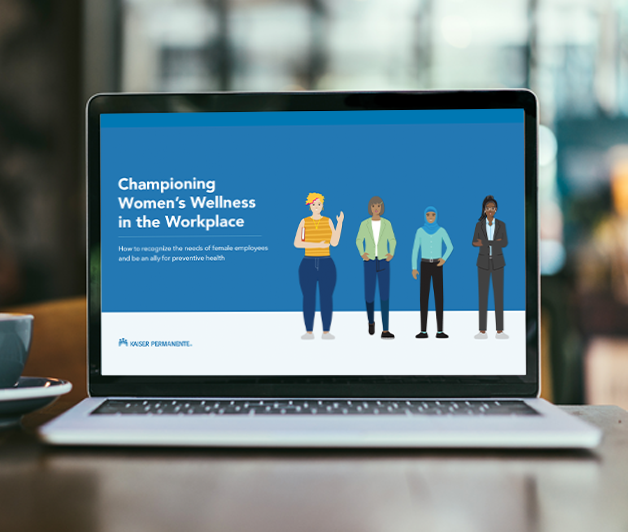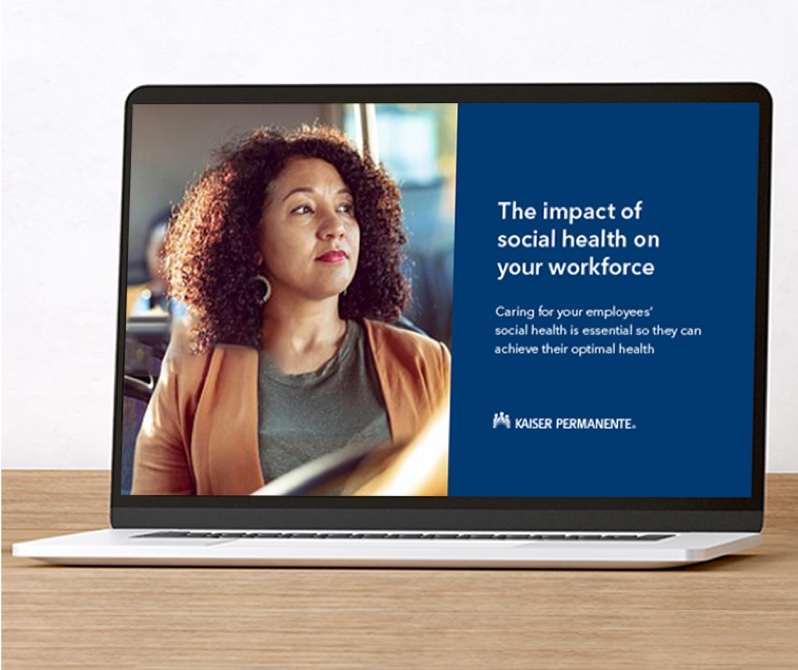

High blood pressure is known as “the silent killer,” because there are often no symptoms, even though it can be deadly. A staggering 44% of American women are living with high blood pressure — also known as hypertension — but only 1 in 5 have it under control.1,2 High blood pressure leads to heart disease, which accounts for about $1 of every $7 spent on health care.3 Most shocking, it’s the leading cause of death for women in the U.S., but only 56% of women recognize that heart disease is their number one killer.4
The good news is that high blood pressure is the single most modifiable risk factor for heart disease. It can be managed — and even prevented — with the right care and support. So, what’s standing in the way for working women, and how can employers help them succeed? As Dr. Nailah Thompson, a Kaiser Permanente board-certified internal medicine, preventive medicine, and lifestyle medicine physician and hypertension specialist, explains, “It’s about meeting women where they are, and tailoring support to your employees’ real-life needs — in and out of the workplace.”
High blood pressure is a tremendous cost driver for employers

High blood pressure costs the U.S. $131–$198B each year.7 Annual health care costs for women with high blood pressure are $7,418 higher than average.8 And compared to employees without high blood pressure, they have:9
- 2.5 times higher inpatient care costs
- Nearly double outpatient care costs
- Nearly triple medication costs
High blood pressure also costs employers an additional $2,362 per employee, per year in combined absenteeism and presenteeism.10
High blood pressure can lead to life-threatening health conditions in women
Left unmanaged, high blood pressure can lead to serious health problems, including heart disease and stroke. In fact, employees with high blood pressure are 3 times more likely to die from heart disease and 4 times more likely to die from stroke.11 High blood pressure in women tends to begin at a younger age — and progress faster — than in men.12 And Black women have the highest prevalence of hypertension in the U.S. — along with 5 times the mortality risk.13


High blood pressure and pregnancy
Though high blood pressure risk isn’t directly related to gender, things like pregnancy can increase women’s risk — both while they’re pregnant and for the duration of their lives.
- 1 in 25 pregnant people experience preeclampsia — high blood pressure during pregnancy that can be life-threatening.16
- 1 in 10 women who didn’t have high blood pressure before or during pregnancy develop hypertension in the first year after giving birth.17

How are high blood pressure and work connected?
The demands, pressures, and challenges associated with work can create chronic stress, which can lead to elevated blood pressure levels. Experiencing discrimination is also a major risk factor for both high stress and high blood pressure. And many common stress-related coping habits — such as eating more, smoking, or drinking alcohol — can raise blood pressure even further.
- Women working 49 or more hours each week are 66% more likely to develop high blood pressure.18
- Women who feel highly discriminated against at work are 54% more likely to have high blood pressure.19
- Black women are disproportionately affected by psychosocial stressors like racial and gender discrimination — both in and out of work — and they have the highest rates of hypertension.20
It’s no wonder businesses that invest in gender equality and equitable workplace health policies also have less absenteeism, greater employee satisfaction and engagement, and better financial performance.21


“The key thing employers need to know about stress is that it’s cumulative. Work stress. Family stress. Financial stress. It builds up and can have a very detrimental effect on not just our blood pressure, but our heart health, our sleep, our mental health.”
—Dr. Nailah Thompson
Promoting hypertension awareness and prevention at work
“Employers can absolutely help employees understand their risk factors, access appropriate care, and influence the prevention and management of high blood pressure among their employees. If they can do that, and make it inclusive and engaging, it’s a win-win for everyone,” Dr. Thompson explains.
- Help employees prioritize their health. Encourage, model, and support them taking time away from work for preventive and routine care, because it helps prevent more costly complications and conditions down the road.
- Provide 360-degree support. Help employees manage stress. Make sure they have access to mental health support. And don’t forget their social health needs.
- Accommodate employees being treated for high blood pressure. For example, employees on certain medications may need more frequent bathroom breaks, or a quiet place to check their blood pressure during the day.
- Consider offering incentives for employees who get regular biometric screenings.
Choosing the right health care partner is essential
Providing access to integrated virtual care and self-monitoring tools for remote patient monitoring can be game-changing for employees with high blood pressure. And working with physicians they trust can help them manage their condition more successfully.
Virtual care offers promising advantages
Employees can manage their high blood pressure just as successfully with telehealth as with in-person appointments — and those who choose telehealth are more satisfied with their care.23
Self-monitoring results in better blood pressure control
In one study, nearly 90% of participants achieved blood pressure control within 2 weeks of receiving their home monitor.24 The long-term return on investment on self-measured blood pressure monitoring is up to $19.34 on the dollar.25 And in an integrated system like Kaiser Permanente, self-monitoring results go straight to your employees’ electronic health record to be reviewed and managed by their primary care team.


Choosing a doctor who delivers culturally responsive care matters
Good relationships with health care teams can make all the difference in preventing or managing high blood pressure. However, not enough women have those relationships: 29% say their doctor dismisses their concerns. And 19% say their doctor assumed something without asking.27

“There’s a lack of trust in the health care system, especially in Black and Brown communities. So, we need to build that trust. It’s a beautiful thing with my patients. They’re honest about what they’re eating, and open about whether they’re taking their medication, because we have that relationship.”
— Dr. Nailah Thompson
Employers can help stop this “silent killer”
How many of your employees are living with this hidden risk? High blood pressure in women is a huge cost driver and the single most modifiable risk factor for heart disease — and it’s one that employers can positively influence. Businesses taking a proactive approach can minimize the impact and maximize returns through lower health care costs and improved outcomes. The long-term benefits to your female employees — and your bottom line — make it well worth the effort.
Championing Women's Wellness in the Workplace
Women should be empowered to put their health first. Discover how you can help lead the change by downloading our interactive guide that explores the connection between women’s health and their career.

About our expert

Along with being a primary care physician at Kaiser Permanente, Dr. Thompson is the program director of the Internal Medicine Health Disparities and Health Equity track at Kaiser Permanente Oakland Medical Center. Dr. Thompson is currently the only clinical hypertension specialist in Kaiser Permanente’s East Bay region, and she founded the Specialty Blood Pressure Clinic at the Oakland Medical Center in 2015. The clinic is dedicated to improving blood pressure control in the East Bay’s Black and African American community and addressing and eliminating health disparities. Dr. Thompson is passionate about equity, inclusion, and diversity, and happy to be serving the community she grew up in. Her most important role is mommy to her son, Naim.
Resources you may find helpful



- 1
“Facts About Hypertension,” CDC.gov, accessed May 31, 2023.
- 2
“Telehealth May Be Just as Good as Clinic Visits for Treating High Blood Pressure,” American Heart Association, October 25, 2022.
- 3
“Control High Blood Pressure,” CDC.gov, accessed May 31, 2023.
- 4
“Lower Your Risk for the Number 1 Killer of Women,” Centers for Disease Control and Prevention, February 3, 2023.
- 5
Jared Ortaliza et al., “How do Health Care Expenditures Vary Across the Population?” Health System Tracker, November 21, 2022.
- 6
Kara E. Macleod et al., “A Literature Review of Productivity Loss Associated with Hypertension in the United States,” Population Health Management, June 7, 2022.
- 7
“The Surgeon General’s Call to Action to Control Hypertension,” U.S. Department of Health and Human Services, 2020.
- 8
See note 5.
- 9
“Adults with High Blood Pressure Face Higher Healthcare Costs,” American Heart Association, May 30, 2018.
- 10
See note 6.
- 11
“Modeling Health and Budgetary Impacts of Team-Based Care for High Blood Pressure,” CDC.gov, accessed June 2, 2023.
- 12
Hongwei Ji et al., “Sex Differences in Blood Pressure Trajectories Over the Life Course,” JAMA Cardiology, March 1, 2020.
- 13
Rahul Aggarwal et al., “Racial/Ethnic Disparities in Hypertension Prevalence, Awareness, Treatment, and Control in the United States, 2013 to 2018,” Hypertension, August 9, 2021.
- 14
Katherine T. Mills et al., “The Global Epidemiology of Hypertension,” Nature Reviews Nephrology, April 2020.
- 15
See note 3.
- 16
“Preeclampsia and High Blood Pressure,” goredforwomen.org, accessed June 7, 2023.
- 17
Samantha E. Parker et al., “De Novo Postpartum Hypertension, Incidence and Risk Factors at a Safety-Net Hospital,” Hypertension, November 15, 2022.
- 18
“Working Too Much Could Lead to High Blood Pressure,” American Heart Association, December 19, 2019.
- 19
Jian Li et al., “Workplace Discrimination and Risk of Hypertension: Findings from a Prospective Cohort Study in the United States,” Journal of the American Heart Association, April 26, 2023.
- 20
Jolaade Kalinowski et al., “Stress Interventions and Hypertension in Black Women,” Women’s Health, 2021.
- 21
Layanna Martin et al., “Why Women’s Right to Health and Gender Equality Should Be Your Business,” openglobalrights.org, accessed June 7, 2023.
- 22
See note 18.
- 23
Thor Christensen, “Telehealth May Be Just as Good as Clinic Visits for Treating High Blood Pressure,” American Heart Association, October 25, 2022.
- 24
“Low-Tech Solution to High Blood Pressure Problems,” Center for Care Innovations, December 8, 2021.
- 25
See note 3.
- 26
See note 3.
- 27
Michelle Long et al., “Women’s Experiences with Provider Communication and Interactions in Health Care Settings: Findings from the 2022 KFF Women’s Health Survey,” Kaiser Family Foundation, February 22, 2023.
Kaiser Permanente health plans around the country: Kaiser Foundation Health Plan, Inc., in Northern and Southern California and Hawaii • Kaiser Foundation Health Plan of Colorado • Kaiser Foundation Health Plan of Georgia, Inc., Nine Piedmont Center, 3495 Piedmont Road NE, Atlanta, GA 30305 • Kaiser Foundation Health Plan of the Mid-Atlantic States, Inc., in Maryland, Virginia, and Washington, D.C., 2101 E. Jefferson St., Rockville, MD 20852 • Kaiser Foundation Health Plan of the Northwest, 500 NE Multnomah St., Suite 100, Portland, OR 97232 • Kaiser Foundation Health Plan of Washington or Kaiser Foundation Health Plan of Washington Options, Inc., 1300 SW 27th St., Renton, WA 98057
Congratulations! You have successfully saved this item.
To access your Saved items any time, open the "Saved Items" folder in the top right corner of the page.
It seems that you do not have cookies enabled. Please enable cookies to make use of all of our site's functionality.
You haven't collected any items yet.
- Save Content
Click the "Save" icon next to the content you want to revisit later.
- Access Your Saved Items
Click on the "Saved Items" link at the top of the page or use the URL we create for you.
Be sure to copy and paste the URL we create for you before you leave the site.
1-5 of 14
Your Link
After leave the site, your saved items will be saved for you at this URL:
http://business.preview.dpaprod.kpwpce.kp-aws-cloud.org/saved-items?user=Share your list
Show Disclaimer +


